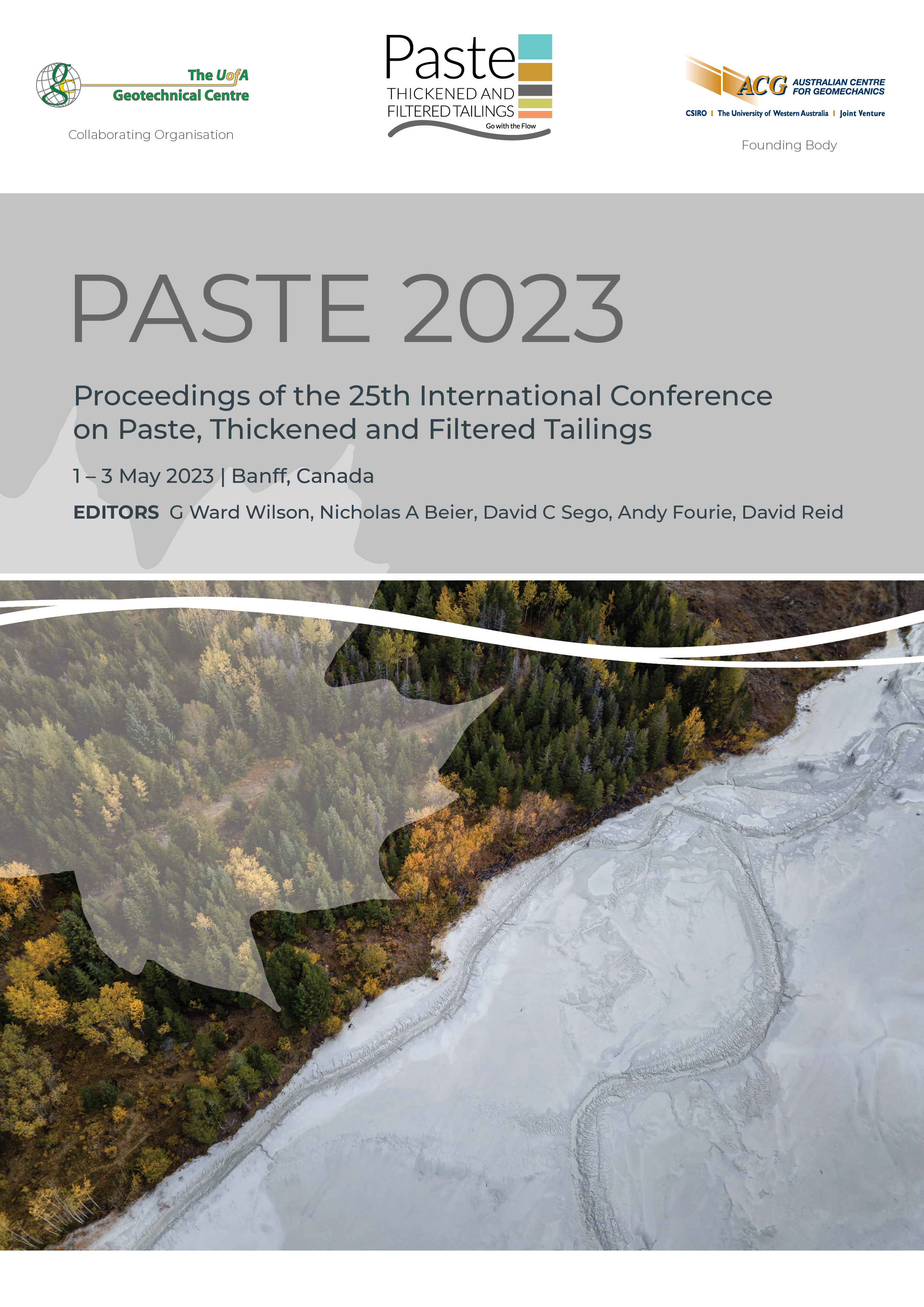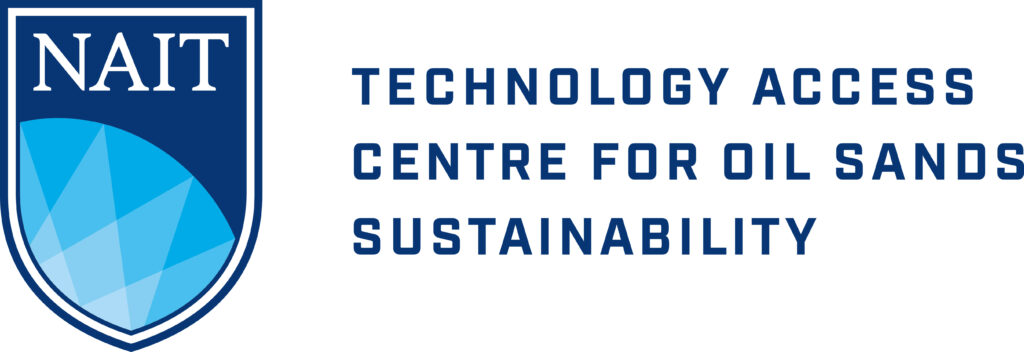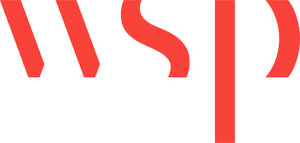The benefit of delithiated beta spodumene to reduce the carbon footprint of cemented paste backfill

|
Authors: Safari, A; Lim, H |
DOI https://doi.org/10.36487/ACG_repo/2355_06
Cite As:
Safari, A & Lim, H 2023, 'The benefit of delithiated beta spodumene to reduce the carbon footprint of cemented paste backfill', in GW Wilson, NA Beier, DC Sego, AB Fourie & D Reid (eds), Paste 2023: Proceedings of the 25th International Conference on Paste, Thickened and Filtered Tailings, Australian Centre for Geomechanics, Perth, pp. 82-97, https://doi.org/10.36487/ACG_repo/2355_06
Abstract:
Delithiated beta spodumene (DBS) is the leach residue produced after lithium refining. It represents the largest material stream produced in the process; approximately seven to ten tonnes of DBS is generated per tonne of lithium hydroxide monohydrate produced. The material is characterised as pozzolanic and is featured in the recently published standard AS3582.4:2022 Supplementary cementitious material: Manufactured Pozzolans. This paper presents an experimental study on the strength behaviour of cemented paste backfill (CPB) containing DBS by investigating different CPB mix designs produced with nickel tailings, mine site-specific recycled process water, and various types of binders. The primary motivation of this collaborative research work was to find ways to reduce CPB’s carbon footprint by using locally sourced material as a binder additive. For this study, several laboratory tests were undertaken at the Nova nickel-copper mine to explore the use of DBS in paste fill design. DBS was used as a partial replacement material for ground granulated blast-furnace Slag (GGBFS) in 9:1 slag-lime binder and mixes with other cementitious binder types such as general purpose (GP), general blended (GB), high early strength (HE), and low heat (LH) cement. The results demonstrated that CPB samples with the DBS-GB, DBS-GP, DBS-HE and DBS-LH mixed binders showed promising results with DBS replacement ratios of up to 40 wt.%; however, CPB samples with the DBS- lime mixes failed to perform to an acceptable strength. Nevertheless, these performed well in achieving the compressive strength required for use at the Nova mine site. At 40 wt.% binder replacement with DBS, paste CO2 emission will be reduced by around 28%. Future studies may consider the long-term performance and other mining applications of DBS.
Keywords: cemented paste backfill (CPB), recycling, delithiated beta spodumene (DBS), cementitious material, lithium leach residue
References:
ASX:IGO 2022, ‘Commercial Production from Kwinana Refinery’, press release, IGO Limited, South Perth, viewed 07 April 2023,
Bentz, DP 2008, ‘A review of early-age properties of cement-based materials’, Cement and Concrete Research, vol. 38, no. 2, pp. 196–204,
Belem, T & Benzaazoua, M 2004, ‘An overview on the use of paste backfill technology as a ground support method in cut-and-fill mines’, in E Villaescusa & Y Potvin (eds), Ground Support 2004: Proceedings of the Fifth International Symposium on Ground Support, Taylor & Francis, London, pp. 637–650.
Casella, J, & Olivares, M 2021, ‘The Western Australia Lithium Industry- Enabling new and sustainable products beyond lithium chemicals’, Annual Western Australia Sustainable Infrastructure Symposium, Australian Centre for Geomechanics, Perth, viewed 07 April 2023,
Chen, QS, Zhang, QL, Fourie, A, Chen, X & Qi, CC 2017, ‘Experimental investigation on the strength characteristics of cement paste backfill in a similar stope model and its mechanism’, Construction and Building Materials, vol. 154, pp. 34–43,
Chen, Q, Zhu, L, Wang, Y, Chen, J & Qi, C 2022, ‘The carbon uptake and mechanical property of cemented paste backfill carbonation curing for low concentration of CO2’, Science of The Total Environment, vol. 852, article no. 158516,
Creagh, B 2018, ‘Independence to introduce Australia-first energy solution at Nova’, Australian Mining, viewed 07 April 2023,
Deng, XJ, Klein, B, Hallbom, DJ, de Wit, B & Zhang, JX 2018, ‘Influence of particle size on the basic and time-dependent rheological behaviour of cemented paste backfill’, Journal of Materials Engineering and Performance, vol. 27, pp. 3478–3487,
Ding, H & Zhang, S 2020, ‘Quicklime and Calcium Sulfoaluminate Cement Used as Mineral Accelerators to Improve the Properties of Cemented Paste Backfill with a High Volume of Fly Ash’, Materials, vol. 13, no. 18, article no. 4018,
Grice, T 1998, ‘Underground mining with backfill’, In Proceedings of the 2nd Annual Summit, Mine Tailings Disposal Systems, Australasian Institute of Mining and Metallurgy, Brisbane, p. 14.
Haigh, M, Dumitru, I, Munn, B & Papworth, F 2013, ‘Development of new high performance supplementary cementitious material - a lithium production by-product’, Proceedings of the CIA Biennial Conference, Understanding Concrete, Concrete Institute of Australia, North Sydney.
He, Y, Zhang, Q, Chen, Q, Bian, J, Qi, C, Kang, Q & Feng, Y 2020, ‘Mechanical and environmental characteristics of cemented paste backfill containing lithium slag blended binder’, Construction and Building Materials, vol. 271, article no. 121567,
Helinski, M, Fahey, M & Fourie, A 2011, ‘Behaviour of cemented paste backfill in two mine stopes: Measurements and modeling’, Journal of Geotechnical and Geoenvironmental Engineering, vol. 137, no. 2, pp. 171–182,
Karrech, A, Dong, M, Elchalakani, M, & Shahin, M 2019, ‘Sustainable geopolymer using lithium concentrate residues’, Construction and Building Materials, vol. 228, article no. 116740,
Karrech, A, Dong, M, Skut, J, Elchalakani, M & Shahin, M 2021, ‘Delithiated beta spodumene as a geopolymer precursor’, Construction and Building Materials, vol. 309, article no. 124974,
Kawai, K, Sugiyama, T, Kobayashi, K & Sano, S 2005, ‘Inventory data and case studies for environmental performance evaluation of concrete structure construction’, Journal of Advance Concrete Technology, vol. 3, no. 3, pp. 435-456,
Kesimal, A, Yilmaz, E, Ercikdi, B, Alp, I & Deveci, H 2005, ‘Effect of properties of tailings and binder on the short-and long-term strength and stability of cemented paste backfill’, Materials Letters, vol. 59, no. 28, pp. 3703–3709,
Lehne, J & Preston, F 2018, ‘Making Concrete Change Innovation in Low-carbon Cement and Concrete Energy’, report, Chatham House, London, viewed 07 April 2023, CID: 20.500.12592/6hw862
Lim, H & Ghisi, M 2021, ‘The Pozzolanic Activity of TAS’, Tianqi Lithium Kwinana Internal Report, Australia, viewed 07 April 2023.
Lim, H & Mirela, G 2021, ‘Update on Pastefill Studies (XRD Results)’, Tianqi Lithium Kwinana Internal Report, Australia, viewed 07 April 2023.
Lindstrom, P & McArdle P 2009, ‘Emissions of Greenhouse Gases in the United States 2008’, U.S. Energy Information Administration, Office of Integrated Analysis and Forecasting, U.S. Department of Energy, Washington, DC.
Munn, B, Dumitru, I & Maree, D 2017, ‘Assessment of the performance of new supplementary cementitious materials from lithium production residues’, Proceedings of the CIA Biennial Conference, Advances in Concrete, Materials and Structures, Adelaide,
Munn, B, Ghisi, M & Skut, J 2021, ‘Further development of new supplementary cementitious materials from processed lithium aluminosilicate materials’, Concrete 2021, Sydney, viewed 07 April 2023,
Pauliuk, S, Heeren, N, Berrill, P, Fishman, T, Nistad, A, Tu, Q, Wolfram, P & Hertwich, EG 2021, ‘Global scenarios of resource and emission savings from material efficiency in residential buildings and cars’, Nature Communications, vol. 12, article no. 5097,
Prince, W 2003, ‘Ettringite formation: a crucial step in cement superplasticizer compatibility’, Cement and Concrete Research, vol. 33, no. 5, pp. 635-641,
Safarizadeh, A & Taheri, A 2021, ‘The effect of changing grinding cycle on the flow-ability of cemented paste backfill: effect of particle size distribution’, in AB Fourie & D Reid (eds), Paste 2021: 24th International Conference on Paste, Thickened and Filtered Tailings, Australian Centre for Geomechanics, Perth, pp. 453-460,
Sakai, K & Kawai, K 2006, ‘Recommendation of environmental performance verification for concrete structures’, Guidelines for Concrete, newsletter, Japan Society of Civil Engineering (JSCE), viewed 07 April 2023,
Sivakugan, N, Rankine, RM, Rankine KJ & Rankine KS 2006, ‘Geotechnical considerations in mine backfilling in Australia’, Journal of Cleaner Production, vol. 14, nos. 12-13, pp. 1168-1175,
Standards Australia 2022, Supplementary cementitious materials, Part 4: Pozzolans — Manufactured (AS 3582.4:2022), Standards Australia, Sydney
Su, Z, Chen, QS, Zhang, QL & Zhang DM 2019, ‘Recycling Lead-Zinc tailings for cemented paste backfill and stabilisation of excessive metal’, Minerals, vol. 9, no. 11, article 710,
Wu, AX, Cheng, H, Yang, Y & Zhang, L 2017, ‘Development and challenge of paste technology in China’, in A Wu & R Jewell (eds), Paste 2017: Proceedings of the 20th International Seminar on Paste and Thickened Tailings, University of Science and Technology Beijing, Beijing, pp. 2-11,
Zambrano, LH, Horta, RB, Bauer, H, Schmidheiny, T, Pesenti, G, Collomb, B, Walker, S, Ketsuwan, S, Kimura, M & Moraes, FE 2002, ‘The cement sustainability initiative’, The World Business Council for Sustainable Development (WBCSD), Conches-Geneva, ISBN 2-940240-24-8, viewed 07 April 2023,
© Copyright 2025, Australian Centre for Geomechanics (ACG), The University of Western Australia. All rights reserved.
View copyright/legal information
Please direct any queries or error reports to repository-acg@uwa.edu.au
View copyright/legal information
Please direct any queries or error reports to repository-acg@uwa.edu.au



